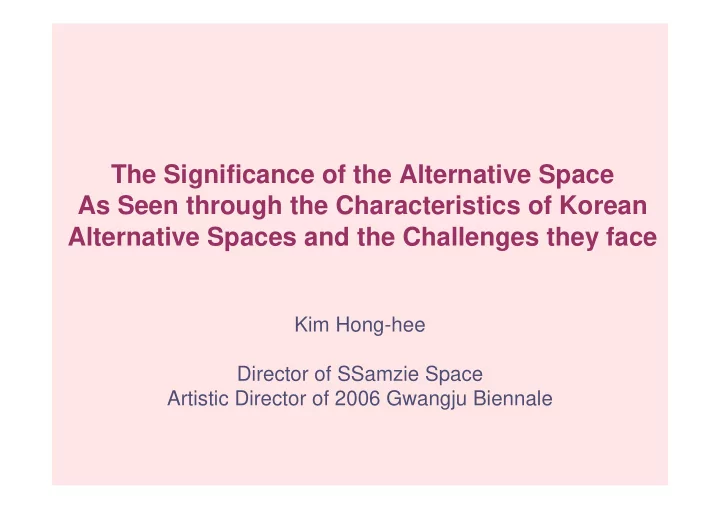

The Significance of the Alternative Space As Seen through the Characteristics of Korean Alternative Spaces and the Challenges they face Kim Hong-hee Director of SSamzie Space Artistic Director of 2006 Gwangju Biennale
1. Introduction: As a Member of Asia's Alternative Space Pursuing Non-Western Values, What are the Characteristics of Korean Alternative Spaces and their Challenges?
1. Introduction: - Alternative spaces and biennales can be seen as a new cultural phenomenon in contemporary Asia since the 1990s. - Alternative space in Asia promotes non-Western values along with efforts to re-map Asia into the world of contemporary art. - Alternative space serves as a cognitive signifier as well as a spatial matrix of the works of artists who are struggling with identity problems. - As a member of Asia's alternative space, what are the characteristics of Korean alternative spaces and their challenges?
2. The Spatiotemporal Context of the Emergence of Alternative Space in Korea: Appeared at the time of IMF Crisis at the End of 1990s and from the backdrop of City of Seoul
2. The Spatiotemporal Context of the Emergence of Alternative Space in Korea Alternative space emerged as a way to overcome the financial crisis (IMF) 1998 SSamzie Art project • 1999 Loop, Sarubia, and Pool • 2000 SSamzie Space • 2000 Insa Art Space and Ilju Art Center •
SSamzie Studio 1998 SSamzie Art project: Launched by SSamzie Inc., providing artists with studios and supporting their domestic and overseas exhibitions
Sarubia Pool Loop, new building 1999 Loop, Sarubia, and Pool: Artists-formed, community-based alternative spaces
2000 SSamzie Space: Multi-cultural space incubating youth art, cutting-edge art, and post-genre art SSamzie Space Curatorial Office
Exhibition View of SSamzie Space
2000 Insa Art Space Ilju Art Center Government-run and corporate Supported organizations Insa Art Space, new building
2. The Spatiotemporal Context of the Emergence of Alternative Space in Korea Metropolis and capital city of Seoul becomes the backdrop of birthplace and cradle for alternative spaces in Korea.
2. The Spatiotemporal Context of the Emergence of Alternative Space in Korea - Pool, Sarubia and Insa Art Space are located in Insa dong, the birthplace of traditional cultures. - SSamzie Space and Loop are located in Hongik University area where youth culture originated.
Insa-dong
Hongik University area
3. The Structural and Systemic Characteristics of Korean Alternative Space: Dependent on Government Funds and Corporate Sponsorship Albeit Alternative and Independent
3. The Structural and Systemic Characteristics of Korean Alternative Space - Loop, Sarubia, and Pool were established as community and friendship-based alternative spaces voluntarily organized by artists. - SSamzie Space, Insa Art Space and Ilju Art Center were formed as affiliated organizations managed by government funds and corporate sponsorships.
3. The Structural and Systemic Characteristics of Korean Alternative Space - Improvements in government support and corporate sponsorships imply the changes of national art policy and business minds. - National, public, and private art museums and commercial art galleries seek for transformation narrowing the gap with alternative spaces. - Korean alternative space manifests ambivalent position, being confrontational and critical against the establishments, while aligning with them.
4. The Orientation and Aspirations of Korean Alternative Space: Characterized by New Generation Artists and Leading the Task of Globalization
4. The Orientation and Aspirations of Korean Alternative Space - The emergence of alternative space boosted new generation artists and transformed the landscape of the Korean art world. - Alternative space and new generation artists are gaining force and becoming mainstream. - New generations emerged from alternative space proclaim overground, starship, internationalization and globalization from the early stages of their career. - Advancement into international stage becomes the biggest aspiration and final goal for the new generational artists. - New generations pursue cosmopolitan Asia, new Asian identity with glocal vision, manifesting themselves as glocal hybrid models.
4. The Orientation and Aspirations of Korean Alternative Space - Choi Jung-hwa, Lee Su-kyung and Ham Kyung-ah utilize Korean traditions and Asian spirits as the main, modal and medium motifs, creating a new aesthetic identity.
Choi Jung-wha
Choi Jung-wha
Lee Su-kyung
Lee Su-kyung
Ham Kyung-ah
Ham Kyung-ah
4. The Orientation and Aspirations of Korean Alternative Space Kim Hong-suk, Jung Yeon-doo, and Yang Hye-kyu come up with a mixture of ideas transcending regional characteristics of Korea and Asia, and establish their own cosmopolitan world of art
Kim Hong-suk
Kim Hong-suk
Jung Yeon-doo
Jung Yeon-doo
Yang Hye-kyu
4. The Orientation and Aspirations of Korean Alternative Space Park Chan-kyung, FlyingCity, Mix Rice and others criticize and reflect on socio-political realities concerning the inter-Korean conflicts, urban development, diaspora and migration labor, changing and expand the Min-jung art spirits of the 80s into a new paradigm.
Park Chan-kyung
Park Chan-kyung
FlyingCity
FlyingCity
Mix Rice
Mix Rice
5. Conclusion: Alternative Spaces in Korea to Serve as a Conduit for Spreading hallyu , or a Korean Wave of Visual Art Through International Networking
5. Conclusion - Globalization is not a confrontation with what is local, but a significant encounter between regions and the world, which leads to returning to roots. - Alternative space in Korea promotes opportunities for direct exchanges among Asian neighbor countries via Asian networking. - Hallyu, or Korean Wave, can be seen as a new quality of contemporary Asia, the subtle mixture of cultural hybridity. - We may carefully propose the possibility of continuity of hallyu of pop culture and the hallyu of visual art. - Alternative spaces or biennales could serve as a conduit for spreading hallyu, achieving the tasks of searching for non- Western values.
Lee Young-ae, Bae Yong-june the most popular hallyu stars
Recommend
More recommend